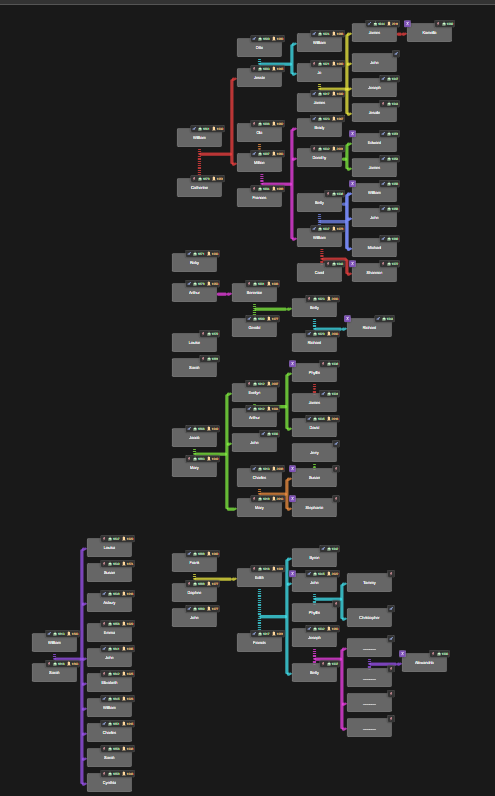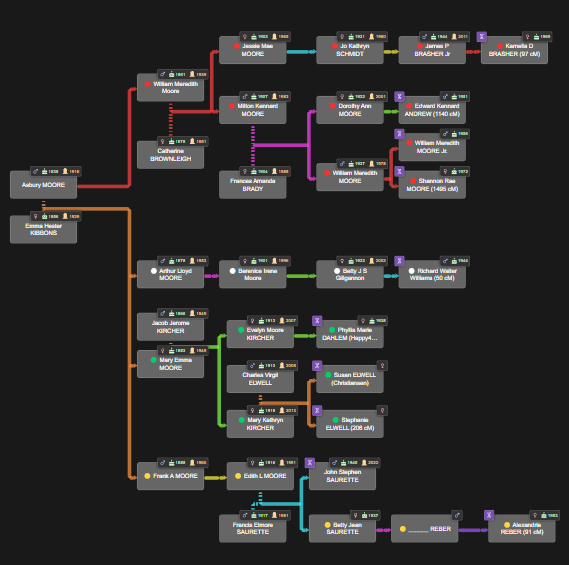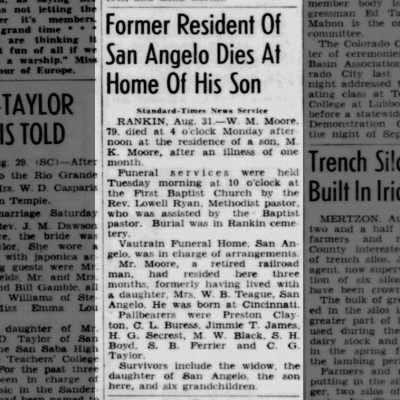Introduction: In Part 1, I introduced you to my paternal great-grandparents, William Meredith Moore and Catherine Brownleigh Moore. I had been able to find some information about them, but I could not verify their origins. They were the proverbial brick walls.
Exploring Genetic Genealogy: After several years of visiting every rabbit hole I could find, I decided about ten years ago to try genetic genealogy to see if DNA would get me any further in my quest. I decided to test with Ancestry first and then 23andMe. When I received my results, I started looking for matches. A few of them were names I recognized, but most were completely unknown to me.
I began the process of looking at matches, seeing if they had trees connected to their DNA profiles (most did not), and contacting the matches who looked most likely to be close relatives. To make a long story short, I found a lot of maternal-side relatives but very few paternal. This went on for several years. Occasionally, someone would appear as a new match, but I couldn’t fill in the blanks in my tree.
I set this brick wall aside for a few years as I worked to build out other parts of my tree that were frankly…easier. The “known” parts of my ancestry went back to colonial times on six of my eight grandparents’ lines. There were (and are) plenty of ancestors to research and document.
Returning to the Brick Walls: Finally, in 2024, I decided to return to my brick walls. I started fresh with new research questions: “Who were the parents of William Meredith Moore, born in Ohio in 1861?” and “Who were the parents of Catherine Brownleigh, born in Ohio in 1878?” I started fresh with my research, using information from Ancestry, FamilySearch, and MyHeritage. I also started working with DNA tests done at Ancestry, 23andMe, FTDNA, and Living DNA.
Unfortunately, I didn’t see that much had changed using traditional genealogy. The few hints that I saw either were easily disproved or didn’t have enough evidence to take them seriously. But DNA was another story.
New Technology Becomes Available: I believe that 2024 is going to be viewed as a watershed year for genetic genealogy. It seems like every vendor introduced one or more new products. I tried many of them, but I’m primarily going to deal with just three in this article.
Ancestry introduced AncestryDNA Plus in September of 2023. A part of that product is Sideview, a tool that assigns most DNA matches to the paternal or maternal side. I thought this was the breakthrough I needed to solve my brick walls.
Well, it wasn’t. It got me closer, but since I was looking for ancestors of both my great-grandfather and great-grandmother, it just gave me a big group of people who didn’t fit anywhere else.
I started building out family trees for as many of these mystery relatives as possible. I reached out to some of them. But, as usual, the response rate for those attempts was minimal, and the few who did respond didn’t have useful information for me. Nevertheless, I went on. I could see that there was a large group of “cousins” who seemed to have some sort of relationship.
Enter BanyanDNA: I have been a fan of Leah Larkin for many years. Her blog, The DNA Geek, is a must-read for me. In July of 2024, she started writing about a new tool that she and a group of really smart people had created. Simply put, it allows us to build out trees, populate our DNA matches, and evaluate hypotheses for how the disparate trees might join. (By the way, I don’t receive anything for mentioning these products. I just think that they could be helpful to other genealogists.)
At about the same time, Ancestry came out with Shared Matches of Matches. This would prove to be the key to solving at least one of my brick walls.
Building and Testing Hypotheses: So, I built trees in BanyanDNA, added how much DNA I matched with everyone I had found, and added how much each of those matches matched with others on the trees. This took some time. I was careful to get all the information correct. When I got everything entered, the result was the tree below.
Various family trees are related to the Asbury Moore family. Tree created on BanyanDNA
Confirming Connections: After building the trees, I built my hypothesis that each family group was connected through one common ancestor. Evidence pointed to the family group on the lower left of the chart above. Using the tools in BanyanDNA, I was able to test each one of the potential parents of my great-grandfather and determine that there was a high likelihood that Asbury Moore was his father. Then, by comparing my great-grandfather’s date of birth to each of Asbury’s wives, I determined that Susan Almira Russell was likely to be his mother.
Family tree of Asbury Moore after DNA connections were confirmed. Chart generated in BanyanDNA. Note: Family members who have not been DNA tested or are not in a direct line have been omitted in order to provide a cleaner chart.
Finding Paper Evidence: There was still one thing nagging at me. I could not find a single paper connection between my great-grandfather and his parents. Everything I knew about him indicated that he had been born in Ohio in 1861. That was what my grandfather had always told me, and it’s what showed up on all the census records I had found. But then, I got lucky. While searching for census records for Asbury and Susan Moore, I came across the record below. Hallelujah! I finally had something on paper that connected them. Of course, the census taker misspelled Asbury’s name, and the transcriber read the surname as “Movr.” But the given names and ages matched up to all three of the family members.
A Wrinkle in the Story: The family was living in Tipton, Indiana, and according to the census, William, my great-grandfather, was born in Indiana, not Ohio, like I’d been told. I had been looking in the wrong place all those years. Births were not recorded in Indiana in 1861, so I’m still looking for other records to back up my hypothesis. But it’s reasonably clear that the DNA connection I had found is correct.
1870 U.S. Census; Cicero Township, Tipton County, Indiana, Roll: M593_363; Page: 450A; Ancestry.com, https://www.ancestry.com/imageviewer/collections/7163/images/4263250_00026?pId=21792122.
Unresolved Mysteries: William does not appear in the 1880 census with the family. His mother died in 1874, and his father remarried in 1876. It’s fair to assume that William moved out of the family home as soon as he could. I can’t find any indication that he remained in contact with the family. He is not mentioned in obituaries for his father.
There are a few other things that bothered me. I still have not been able to locate William’s death certificate. I’ve seen his marker at the cemetery in Rankin, Texas, where he died. But the certificate itself seems to have been destroyed or misfiled. I was beginning to wonder if he had died in Rankin or if he had died somewhere else. Then, in another stroke of luck, I found a newspaper article about his death and funeral. For once, it was exactly as I had been told.
Source: The San Angelo [Texas] Weekly Standard, 1 September 1939, page 6, imaged: Newspapers.com, https://newspapers.com/image/78155921, accessed 7 February 2025.
I am still working to fill in the gaps, but the basic story can now be told. I’m now working to document generations further removed from me. But that will be a story for another time.









Sometimes it is a very slow process. Always a satisfying moment when you can confirm DNA and paper records. I am looking forward to the new clustering tool being rolled out by ancestry. Maybe it will help. I did make some breakthroughs with clustering some years ago.
That’s a great article Bill. I’ve not heard of BanyanDNA so I’ll go check it out. Maybe it’ll help me solve my brick wall.